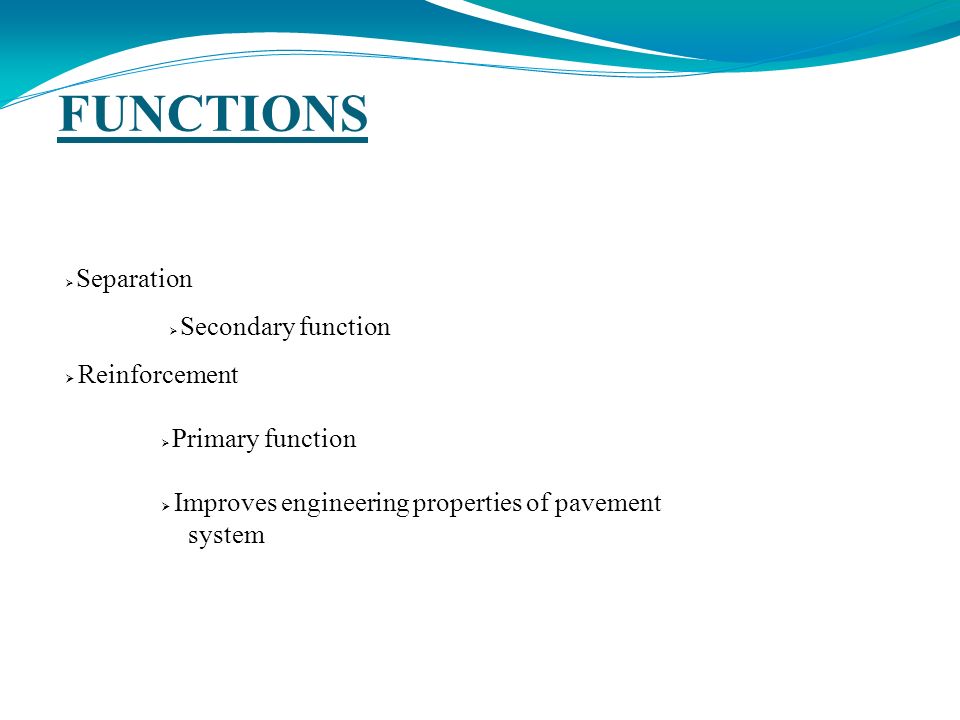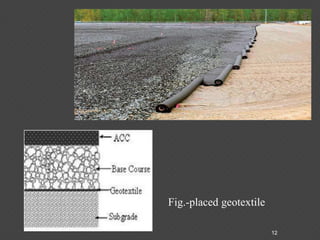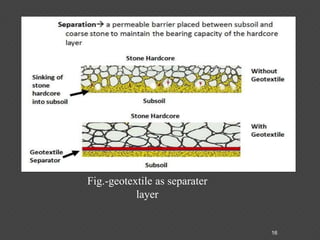The design engineer should be well aware of the possible problems and should use this relatively new tool for solving them. Specifically geosynthetics have been used for separation Zornberg JG.
TOPIC- PAVEMENT DESIGN SUBMITED TO.

. Two design methods were used to quantify the improvements of using geotextiles in pavements. Ppt on pavement design 1. The use of geotextiles in filter applications is probably the oldest the most widely known and the most used function of geotextiles.
They offer ideal tensile modulus values at low tensile strain levels exceeding biaxial and multi-axial geogrids and the filtration-drainage benefit of high permittivity geotextiles. The growth in their use worldwide for transportation applications in particular has been nothing. Also costs to users is urgently needed to assess the benefits of using geotextile in secondary road flexible pavement.
Reinforcement is the synergistic improvement in pavement strength created by the introduction of a geotextile into a pavement layer. What is a Pavement. The geotextile protects soil surfaces from the tractive forces of moving water or wind and rainfall erosion.
CONCLUSION Geotextiles are an efficient effective and economic method of solving most of the geotechnical problems in roads. The average is 26. Geotextiles are very important part of pavement construction regarding its strength durability and working performance.
The primary design consideration for such geotextile are construction survivability and soil retention. PLACING OF GEO-TEXTILES IN PAVEMENT- Pavements typically consist of a bituminous or concrete surface an engineered aggregate base or support layer and then the natural soil subgrade. The effects of three flexible pavement design parameters were evaluated.
What is a Pavement. For instance using curve A with the lowest traffic volume from Figure 6 it shows that sample B. It is to be placed just above the subgrade and below the base course.
Geotextiles play a significant part in modern pavement design and maintenance techniques. Knitted GT A geotextile made by inter-looping one or a lot of yarns beside a textile machine rather than a weaving loom Stitched GT A geotextile within which fibres or yarns or each ar interlocked by handicraft or stitching. Advances in the Use of Geosynthetic in Pavement Design.
Has often been fulfilled by geogrids geotextiles have been used extensively as. Design For Pavement Thickness Flexible pavements are designed in such a way that the load transmitted to the subgrade does not exceed its bearing capacity. A major initiative in pavement design was the development and implementation of the Mechanistic-Empirical M-E methods.
While the M-E Pavement Design Guides MEPDG have been officially adopted eg Australia 2004 and AASHTO 2008 these guides do not include the evaluation of pavement performance when. Materials in pavement design. And their impact on the results was investigated.
Performance and Evaluation of Pavement Design w ith and without using Geotextiles Aniket S. Raut 1 Akshay A. 52 JUTE FIBRES Use of Jute Geotextiles for Improving Performance of PMGSYRoads To study the use of jute geotextile in the road pavement Benefit of JGT of varying strength as an agent for improvement in load bearing capacity of the subgrade specifically the subgrade CBR and overall improvement in pavementperformance Role of open weave JGT as bio-engineering.
OR Highway pavement is a structure consisting of superimposed layers of selected and processed. Al-Qadis design method suggests that when a geotextile is placed in a pavement as a separator the range of the total pavement life cycle cost savings can be as high as 70 to as low as 40. However a design carried out in accordance with this guide has no.
Geotextiles a newly emerging field in the civil engineering and other fields offer great potential in varied areas of applications globally. Topics For Seminar March 13 2014. In this application the geotextile is placed in contact with and down gradient of soil to be drained.
GEOSYNThETiCS iN PAvEmENT dESiGN Geosynthetics have been used in pavement design to address the functions of separation filtration lateral drainage sealing and reinforcement. For this heshe should understand properties and capabilities of the geotextile material. Geotextiles are the preferred geosynthetic solution to use for flexible pavement design and construction on low California Bearing Ratio CBR strength subgrade soils.
Very useful in case of silt and clay. Lawhale 4 Sujesh D. Jangale 3 Pratik O.
The study concludes that the cost effectiveness ratio from the two design methods shows that the lowest cost-effectiveness ratio using Al-Qadis design method is 17 and the highest is 32. Fig-1Geotextiles Wovengeotextiles Non Woven geotextile 212. This depends on the selected design alternative.
Fig-geotextile controlling errosion 23 24. While this abundance of new products has led to reduction in costs it has also made it. A geotextile is defined as any permeable textile material that is used with foundation soil rock earth etc to increase stability and decrease wind and water erosion.
Function in pavements. A multi layer system that distributes the vehicular loads over a larger area 2 3. The capacity for flow of water normal to the plane of the geotextile is referred to as permittivity.
The benefits of using geotextiles in pavements and other transportation applications have triggered a proliferation of products. While the function of reinforcement in the US. A geotextile may be made of synthetic or natural fibers.
Geotextile apparent opening size is related by a factor of 12 to 1 with d85 size of the soil being retained. Dahiwade 2 Kamalshil R. One was developed at Virginia Tech by Al-Qadi in 1997 and the other was developed at Montana State University by Perkins in 2001.
Geotextile construction damage decreases exponentially with an increase in mass per unit area. Table 147 presents a comparative pavement design using the ALIZE software and considering a TC620 traffic category cumulative traffic over 20 years in the range between 65 and 175 million 13-t axles a 4-cm BBM overlay and a PF3 pavement formation class 120 MPa. 2 Use of the Design Guide and Pavement Options This document is intended to cover the design of new schemes of any size and reconstruction or rehabilitation on existing highways.
GAJENDRA RAGHUWANSHI SUBMITED BY. Geo-textile is used as a support layer that has many advantages. This manual covers physical properties functions design methods design details and construction procedures for geotextiles as used in pavements railroad beds retaining wall earth embankment rip-rap concrete revetment and drain construc- tion.
Reinforcement Strengthening of soil slopes RE Wall for bridges approach Construction on soft soil Reinforcing pavement layers are some major uses of Geotextile B. Consequently the thickness of layers subbase and base course varies with CBR of soil and it affects the cost of pavement. In contrast a geomembrane is a continuous membrane-type liner or barrier Geomembranes must.
FUNCTIONS OF GEOTEXTILE IN PAVEMENT CONSTRUCTION AND DESIGN A. Geotextiles one among the different geosynthetic products can be used for a number of functions or applications in pavement design.

Geosynthetics In Road Construction Ppt Video Online Download

Use Of Geogrids In Flexible Pavement Ppt Video Online Download

Geotextiles In Transportation Applications Ppt Video Online Download






0 comments
Post a Comment